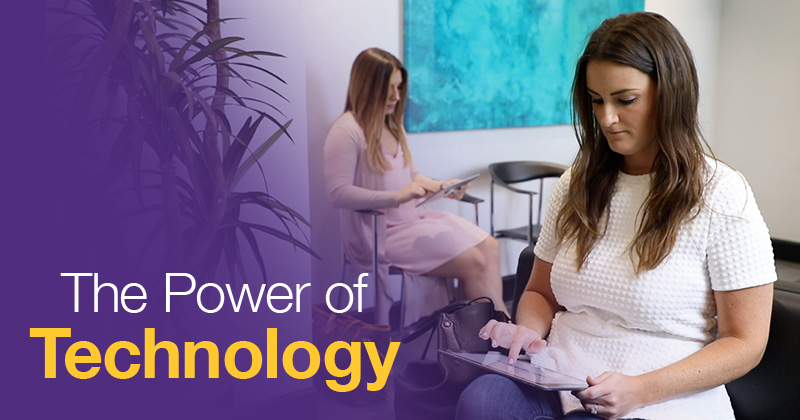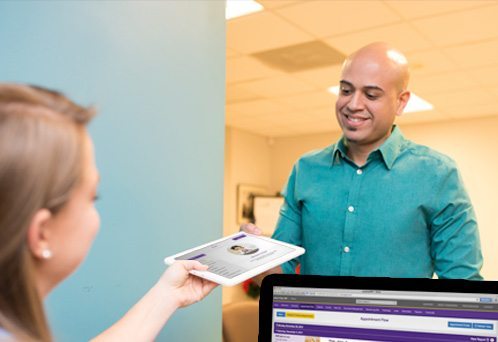Four Reasons to Digitize Your Medical Practice’s Front Office

Streamline Your Workflow so you can Focus on Providing High-Quality Care
Effective practice management is a vital element of patient care, and it all starts with an efficient front office. Unfortunately, the level of administration and paperwork required in healthcare can often make it feel like maintaining peak efficiency is a difficult standard to uphold. For many offices, keeping up with its current medical record and practice management system, whether it be paper-based or digital is difficult enough without the added stress of digitization.
As electronic medical record (EMR) systems become the industry standard, practices are quickly finding that the benefits of digitization far outweigh negatives. Technology can not only help physicians — it can help improve every part of the patient experience while alleviating stress and redundant data entry on front office staff.
While the time and effort required to transition to a digital front office may seem daunting, most practices see significant improvements in efficiency, staff morale and patient engagement. On the fence?
Here are four reasons to consider digitizing your practice and front office:
 1. It Can Help Save Time
1. It Can Help Save Time
It’s common for front office staff to feel overwhelmed — it often seems as though there are more administrative tasks to be done than could possibly fit in a day. For offices still using paper systems or antiquated EMR software, these repetitive tasks add up. They take up significant staff time, require switching tasks frequently and this can be disheartening.
By implementing an intuitive EMR system that offers an all-in-one, integrated solution, practices often find that staff spends less time on redundant tasks. They are no longer tethered to the phone, sending billing reminders, appointment confirmations, answering questions or manually entering patient information — instead, the software helps streamline all of those tasks. Thank you, technology!
For example, a practice management system that integrates with your EMR system can eliminate expensive and inefficient bridges, making it easier to streamline check-in, checkout, scheduling and document management. Having all the information in one place can enable your staff to become that much more efficient.
“Having a pain management EMR and integrated practice management software has streamlined my workflow and improved efficiencies throughout my practice,” stated Jonathan Kamerlink, MD, Kamerlink Pain Institute.
Let’s look at the role of your front desk staff. Whatever practice management software you opt for, it should provide your staff with detailed, automated eligibility verification all before the patient even walks in the door. Access to straightforward financials should show patient balances at check-in and checkout enabling them to have those difficult conversations more easily with patients.
It should eliminate any hunt-and-peck searching to find the right appointment slot for a patient, and seamlessly pull up open slots based on criteria. When using an all-in-one system and combining the power of your EMR and practice management system, you should be able to access follow-up care details, next steps and provider recommendations at checkout.
A digital front office can also help with inter-office communication and let staff focus their energy, batch work more effectively and prioritize the patient experience. In the end, this helps alleviate stress, save valuable time and create a more pleasant working environment.
2. It Can Help Improve Business Operations
When practices switch to a digital solution for the front office, they can experience a far more effective billing process. From accessing records and diagnostic codes to sending bills and collecting payment, every step can be easier with an integrated cloud-based EMR. These practices also report that patients are more likely to pay their bills, shoring up the bottom line and saving staff time on follow-up.
A digital front office can also allow for more practice growth — when the EMR system increases efficiency, practices can increase their patient loads and thereby increase business operations and financial impact. By providing a consistently enjoyable patient experience, they increase the likelihood that patients will recommend the practice to their friends and family members.
Jessica Kappelman, MD, MPH at Kappelman Dermatology, said “The all-in-one modmed Dermatology suite, with EMA, PM and Business Operations Services, is worth the investment to have the confidence that my business is taken care of. I trust that Modernizing Medicine is looking out for the financial health of my practice, and I have confidence that I am earning what I deserve.”
3. It Can Help You Increase Patient Satisfaction

When front office staff aren’t weighed down with repetitive administrative tasks, they have more capacity to focus on the patient experience. By improving staff morale, digital front offices can also lead to more positive interactions between patients and practice staff.
Digitization allows practices to communicate more clearly and consistently with patients, in turn helping them feel informed, empowered and cared for. And, automating processes like check-in and billing helps patients know what to expect so they’re able to relax when they come into the office — an experience that can otherwise be stressful.
“The benefits of EMA continue and now we can take advantage of the modmed Dermatology suite of products, which has automated processes and helped from a workflow perspective. Our staff doesn’t have to move from system to system, and patient information such as pathology reports, follow-up appointments, account balances, etc. are now easily accessible. It also makes our patients feel more confident in our ability to care for them because they’re not being asked multiple times ‘what did the doctor advise, when would you like to come back.’ We already know. It gives the patient satisfaction and also gives us more efficiency,” expressed Tom McNeil, CEO, Premier Dermatology
4. It Helps to Enhance Patient Engagement
Patient engagement is generating quite a buzz in healthcare tech — and for good reason. It is vital to effective treatment and positive outcomes. Because they are able to communicate better with patients, practices with digitized front offices find that patients are more engaged in managing their own care. One tool in the patient engagement toolbox should be a patient kiosk to help streamline check-in and eliminate time consuming and error-prone data entry for staff.
Kelly Poole, BSN, RN, Director of Clinical Operations, Schweiger Dermatology Group shared, “We recently began using modmed Kiosk, so patients can fill out their paperwork using an iPad at check-in. This functionality has proven to be a time saver, saving the medical assistants from collecting the data themselves.”
Digitization provides staff with more bandwidth to respond to inquiries, and patients have a direct line to reach their provider with questions and concerns. Patient portals also help streamline communication within the practice and help communicate more effectively with patients.
Plus, tools like telehealth especially when it’s integrated into your EHR, have benefits for healthcare professionals and patients alike.
Is it Time to Digitize Your Medical Practice?
Digital front offices can enjoy many, many benefits, and among the most important are better communication with patients, improved interoffice communication and, ultimately, more effective care and overall efficiency.
While it can be easy to settle for doing things the way they’ve always been done, medical practices often find that when they digitize their front office and invest in a cloud-based EMR, they more than make up for both the time and financial investment.